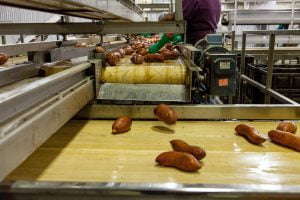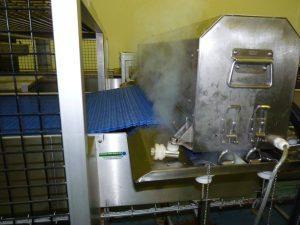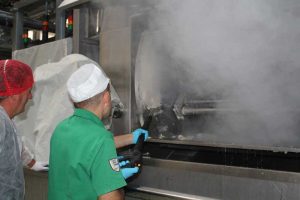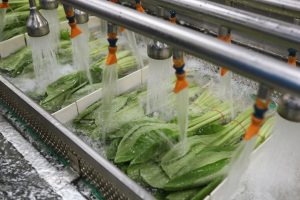Conveyor systems play a crucial role in many industries, allowing for the efficient movement of materials and products throughout the production process. However, over time, these conveyors can become dirty and contaminated, leading to a decline in production efficiency and product quality. This is why conveyor cleaning is essential for maintaining optimal production levels.
Dirty conveyors can have a negative impact on production efficiency in several ways. Firstly, the accumulation of dirt, dust, and debris on the conveyor belts can cause them to become less effective in transporting materials. This can result in slower production speeds and increased downtime as the belts may need to be cleaned or replaced more frequently.
Secondly, dirty conveyors can also lead to product contamination. If the conveyors are not properly cleaned, contaminants such as dirt, grease, or bacteria can transfer onto the products being transported. This can compromise product quality and safety, leading to customer complaints or even recalls.
To avoid these issues and ensure optimal production levels, it is crucial to implement an effective conveyor cleaning system. By regularly cleaning and maintaining the conveyors, companies can improve production efficiency, reduce downtime, and enhance product quality.
Types of Conveyor Cleaning Systems Available in the Market
There are several types of conveyor cleaning systems available in the market today. Each type has its own advantages and disadvantages, depending on the specific needs of the industry or application.
One common type of conveyor cleaning system is the manual cleaning system. This involves physically removing dirt and debris from the conveyor belts using brushes, scrapers, or vacuum systems. Manual cleaning systems are often cost-effective and easy to implement. However, they require regular maintenance and can be time-consuming if the conveyor system is large or complex.
Another type of conveyor cleaning system is the automated cleaning system. These systems use mechanical devices such as brushes or scrapers to clean the conveyor belts automatically. Automated systems are often more efficient and can save time compared to manual cleaning. However, they can be more expensive to install and maintain.
There are also specialized conveyor cleaning systems available for industries with specific cleaning requirements. For example, in the food industry, there are conveyor cleaning systems designed to meet strict hygiene standards and prevent cross-contamination. These systems often use high-pressure water jets or steam to clean the conveyors thoroughly.
Benefits of Using an Efficient Conveyor Cleaning System
Using an efficient conveyor cleaning system can bring several benefits to a company’s production process. Firstly, it can improve production efficiency by ensuring that the conveyors are operating at their optimal performance levels. Clean conveyor belts are more effective in transporting materials, resulting in faster production speeds and reduced downtime.
Secondly, an efficient conveyor cleaning system can enhance product quality. By removing dirt, debris, and contaminants from the conveyors, companies can prevent product contamination and ensure that their products meet the highest quality standards. This can lead to increased customer satisfaction and loyalty.
Furthermore, using an efficient conveyor cleaning system can also extend the lifespan of the conveyor belts. Regular cleaning and maintenance can prevent the build-up of dirt and debris that can cause premature wear and tear on the belts. This can save companies money in the long run by reducing the need for frequent belt replacements.
Factors to Consider When Choosing a Conveyor Cleaning System
| Factor | Description |
|---|---|
| Conveyor Type | Different types of conveyors require different cleaning systems. For example, a belt conveyor may require a different cleaning system than a roller conveyor. |
| Material Being Conveyed | The type of material being conveyed can affect the type of cleaning system needed. For example, a food processing plant may require a cleaning system that is food-safe. |
| Cleaning Frequency | The frequency of cleaning required can affect the type of cleaning system needed. For example, a conveyor that requires daily cleaning may require a different system than one that only needs to be cleaned weekly. |
| Accessibility | The accessibility of the conveyor can affect the type of cleaning system needed. For example, a conveyor that is difficult to access may require a cleaning system that can be operated remotely. |
| Environmental Factors | The environment in which the conveyor operates can affect the type of cleaning system needed. For example, a conveyor operating in a wet environment may require a cleaning system that can handle moisture. |
| Budget | The budget available for a cleaning system can affect the type of system that can be purchased. For example, a high-end cleaning system may not be feasible for a small business with a limited budget. |
When choosing a conveyor cleaning system, there are several factors that companies should consider to ensure they select the right system for their specific needs.
Firstly, it is important to consider the type of material being transported on the conveyors. Different materials may require different cleaning methods or equipment. For example, if the conveyors are used to transport sticky or oily substances, a system that uses high-pressure water jets or steam may be more effective in removing these contaminants.
Secondly, companies should consider the size and complexity of their conveyor system. Larger or more complex systems may require more advanced cleaning equipment or automated systems to ensure thorough cleaning. On the other hand, smaller or simpler systems may be adequately cleaned using manual methods.
Another factor to consider is the level of hygiene required for the industry or application. Industries such as food processing or pharmaceuticals may have strict hygiene standards that need to be met. In these cases, a conveyor cleaning system that can effectively sanitize the conveyors and prevent cross-contamination may be necessary.
Lastly, companies should also consider their budget and available resources when choosing a conveyor cleaning system. Some systems may require a higher upfront investment but offer long-term cost savings through improved efficiency and reduced maintenance needs. It is important to weigh the costs and benefits of different systems to find the most suitable option.
How to Implement an Effective Conveyor Cleaning Program
Implementing an effective conveyor cleaning program involves several steps to ensure that the system is properly set up and maintained.
The first step is to assess the current state of the conveyor system and identify any areas that require cleaning or maintenance. This can be done through visual inspections or by using specialized equipment such as belt scanners or infrared thermography. By identifying areas of concern, companies can prioritize their cleaning efforts and allocate resources accordingly.
Once the areas requiring cleaning have been identified, companies should develop a cleaning schedule or routine. This should include regular cleaning intervals and specify the cleaning methods or equipment to be used. It is important to ensure that the cleaning schedule does not disrupt production and that it is feasible to implement with the available resources.
Next, companies should train their employees on proper conveyor cleaning techniques. This includes teaching them how to safely operate any cleaning equipment, as well as educating them on the importance of maintaining clean conveyors for optimal production efficiency and product quality. Regular training sessions or refresher courses should be provided to ensure that employees are up-to-date with the latest cleaning procedures.
To monitor the effectiveness of the conveyor cleaning program, companies should establish performance metrics or key performance indicators (KPIs). These can include metrics such as conveyor downtime, product quality, or maintenance costs. By regularly measuring and analyzing these metrics, companies can identify any areas for improvement and make adjustments to their cleaning program as needed.
Common Conveyor Cleaning Challenges and Solutions

While implementing a conveyor cleaning program can bring many benefits, there are also common challenges that companies may face. One common challenge is the accumulation of hard-to-remove contaminants on the conveyor belts, such as sticky substances or adhesives. These contaminants can be difficult to remove using traditional cleaning methods.
To overcome this challenge, companies can consider using specialized cleaning equipment or chemicals that are specifically designed to remove these types of contaminants. For example, there are conveyor cleaning systems available that use high-pressure water jets or steam to effectively remove sticky substances from the belts.
Another common challenge is maintaining consistent cleaning standards across different shifts or operators. Inconsistent cleaning practices can lead to variations in production efficiency and product quality. To address this challenge, companies should provide thorough training to all employees involved in the cleaning process and establish clear guidelines or standard operating procedures (SOPs) for cleaning.
Furthermore, companies should also regularly inspect and maintain their cleaning equipment to ensure that it is functioning properly. This includes checking for any wear and tear on brushes or scrapers, replacing worn-out parts, and calibrating any automated systems. Regular maintenance can help prevent breakdowns or malfunctions that can disrupt the cleaning process.
Best Practices for Maintaining an Efficient Conveyor Cleaning System
To maintain an efficient conveyor cleaning system, there are several best practices that companies should follow.
Firstly, regular inspections and maintenance of the conveyor system are essential. This includes checking for any signs of wear and tear on the belts, rollers, or other components, as well as ensuring that the cleaning equipment is functioning properly. Any issues should be addressed promptly to prevent further damage or disruptions to the cleaning process.
Secondly, companies should establish a preventive maintenance program for their conveyor cleaning system. This can include regular cleaning equipment inspections, lubrication of moving parts, and calibration of automated systems. By proactively maintaining the system, companies can prevent breakdowns or malfunctions that can lead to production delays or product contamination.
Another best practice is to regularly review and update the cleaning procedures or SOPs. As new technologies or cleaning methods become available, companies should assess whether these can improve the efficiency or effectiveness of their cleaning program. Regularly reviewing and updating the procedures can help ensure that the cleaning program remains up-to-date and aligned with industry best practices.
Lastly, companies should also encourage feedback from employees involved in the cleaning process. They may have valuable insights or suggestions for improving the efficiency or effectiveness of the conveyor cleaning system. By fostering a culture of continuous improvement, companies can identify and implement changes that can further optimize their production process.
How to Train Employees on Proper Conveyor Cleaning Techniques
Training employees on proper conveyor cleaning techniques is crucial for maintaining an efficient and effective cleaning program. Here are some steps to follow when training employees:
1. Start by providing an overview of the importance of conveyor cleaning for optimal production efficiency and product quality. Explain how clean conveyors can improve material flow, reduce downtime, and prevent product contamination.
2. Demonstrate the proper use of cleaning equipment and tools. This includes showing employees how to safely operate brushes, scrapers, vacuum systems, or any other equipment used in the cleaning process. Emphasize the importance of following safety guidelines and wearing appropriate personal protective equipment (PPE).
3. Teach employees how to identify areas that require cleaning or maintenance. This can be done through visual inspections or by using specialized equipment such as belt scanners or infrared thermography. Show them how to identify signs of wear and tear on the belts, rollers, or other components.
4. Provide step-by-step instructions on how to clean the conveyors effectively. This includes teaching employees how to remove dirt, debris, or contaminants from the belts, as well as how to clean other components such as rollers or pulleys. Emphasize the importance of thorough cleaning and attention to detail.
5. Conduct hands-on training sessions where employees can practice their cleaning techniques under supervision. This allows them to gain practical experience and receive feedback on their performance. Encourage employees to ask questions and provide additional guidance or clarification as needed.
6. Regularly review and reinforce the training by conducting refresher courses or workshops. This can help ensure that employees are up-to-date with the latest cleaning procedures and best practices. It is also an opportunity to address any issues or challenges that employees may have encountered during their cleaning duties.
By providing comprehensive training on proper conveyor cleaning techniques, companies can ensure that their employees have the necessary skills and knowledge to maintain clean conveyors and optimize production efficiency.
Case Studies: Successful Implementation of Conveyor Cleaning Systems in Various Industries
There are numerous case studies of successful implementation of conveyor cleaning systems in various industries. Here are a few examples:
1. Food Processing Industry: A food processing company implemented an automated conveyor cleaning system using high-pressure water jets and steam. This system effectively removed contaminants such as grease, oil, and food residues from the conveyors, ensuring compliance with strict hygiene standards. As a result, the company experienced improved production efficiency, reduced downtime, and enhanced product quality.
2. Automotive Industry: An automotive manufacturing plant implemented a manual conveyor cleaning system using brushes and scrapers. By regularly cleaning the conveyors, the company was able to prevent the build-up of dirt and debris that could cause damage to the belts or other components. This resulted in reduced maintenance costs and increased conveyor lifespan.
3. Pharmaceutical Industry: A pharmaceutical company implemented a specialized conveyor cleaning system designed to meet strict hygiene standards. This system used high-pressure water jets and sanitizing agents to thoroughly clean the conveyors and prevent cross-contamination. As a result, the company was able to ensure product safety and quality, leading to increased customer satisfaction.
These case studies demonstrate the benefits that companies can experience by implementing an effective conveyor cleaning system. By choosing the right system for their specific needs and following best practices for maintenance and employee training, companies can optimize their production process and enhance product quality.
Future Trends in Conveyor Cleaning Technology and Innovation
The field of conveyor cleaning technology is constantly evolving, with new trends and innovations emerging to improve production efficiency and reduce maintenance needs. Here are some future trends to watch out for:
1. Advanced Cleaning Equipment: There is a growing trend towards the development of more advanced cleaning equipment for conveyors. This includes the use of robotics or automated systems that can clean the conveyors more efficiently and accurately. These systems may incorporate artificial intelligence or machine learning algorithms to optimize the cleaning process.
2. IoT Integration: The integration of Internet of Things (IoT) technology into conveyor cleaning systems is another emerging trend. IoT sensors can be used to monitor the condition of the conveyors in real-time, allowing for predictive maintenance and proactive cleaning. This can help companies identify potential issues before they cause production delays or product contamination.
3. Green Cleaning Solutions: With increasing environmental concerns, there is a growing demand for green cleaning solutions in the industry. This includes the development of eco-friendly cleaning agents or technologies that minimize water or energy consumption. Companies are also exploring alternative cleaning methods such as dry ice blasting or ultraviolet (UV) light disinfection.
4. Remote Monitoring and Control: Remote monitoring and control capabilities are becoming more prevalent in conveyor cleaning systems. This allows companies to monitor and control the cleaning process from a central location, reducing the need for on-site personnel. Remote monitoring can also provide real-time data and analytics on the performance of the cleaning system, allowing for continuous improvement.
These future trends in conveyor cleaning technology and innovation are expected to have a significant impact on the industry. By embracing these trends and adopting new technologies, companies can further optimize their production efficiency, reduce maintenance costs, and enhance product quality.
FAQs
What is a conveyor cleaning system?
A conveyor cleaning system is a set of equipment and processes designed to clean conveyor belts and other conveyor components to maintain hygiene and prevent contamination in food processing, pharmaceutical, and other industries.
What are the benefits of using a conveyor cleaning system?
Using a conveyor cleaning system can help prevent contamination, reduce downtime, increase productivity, and improve safety in the workplace. It can also extend the lifespan of conveyor components and reduce maintenance costs.
What are the components of a conveyor cleaning system?
A conveyor cleaning system typically includes a conveyor belt cleaner, a conveyor belt scraper, a conveyor belt brush, a conveyor belt washing system, and a conveyor belt drying system. Other components may include a conveyor belt tracking system, a conveyor belt tensioning system, and a conveyor belt inspection system.
How does a conveyor cleaning system work?
A conveyor cleaning system works by removing debris, dirt, and other contaminants from the conveyor belt and other conveyor components. This is typically done using a combination of mechanical and chemical cleaning methods, such as scraping, brushing, washing, and drying.
What types of conveyor cleaning systems are available?
There are several types of conveyor cleaning systems available, including manual cleaning systems, semi-automatic cleaning systems, and fully automatic cleaning systems. The type of system used will depend on the specific needs and requirements of the industry and application.
What factors should be considered when selecting a conveyor cleaning system?
When selecting a conveyor cleaning system, factors such as the type of conveyor, the type of product being conveyed, the level of contamination, and the required level of hygiene should be considered. Other factors may include the size and layout of the facility, the available space and resources, and the budget for the system.










